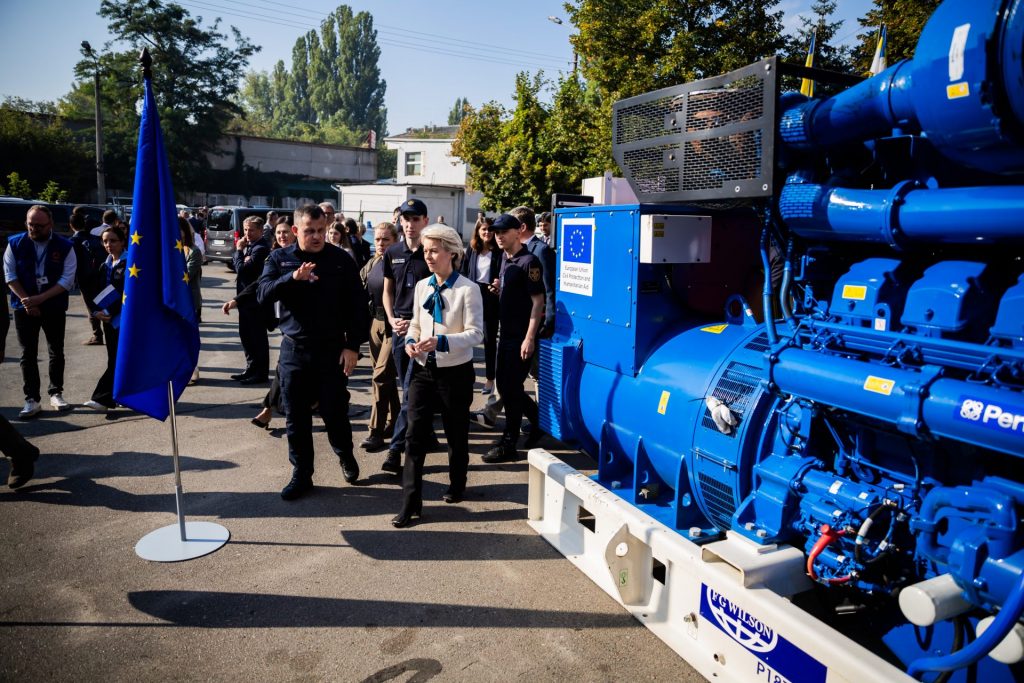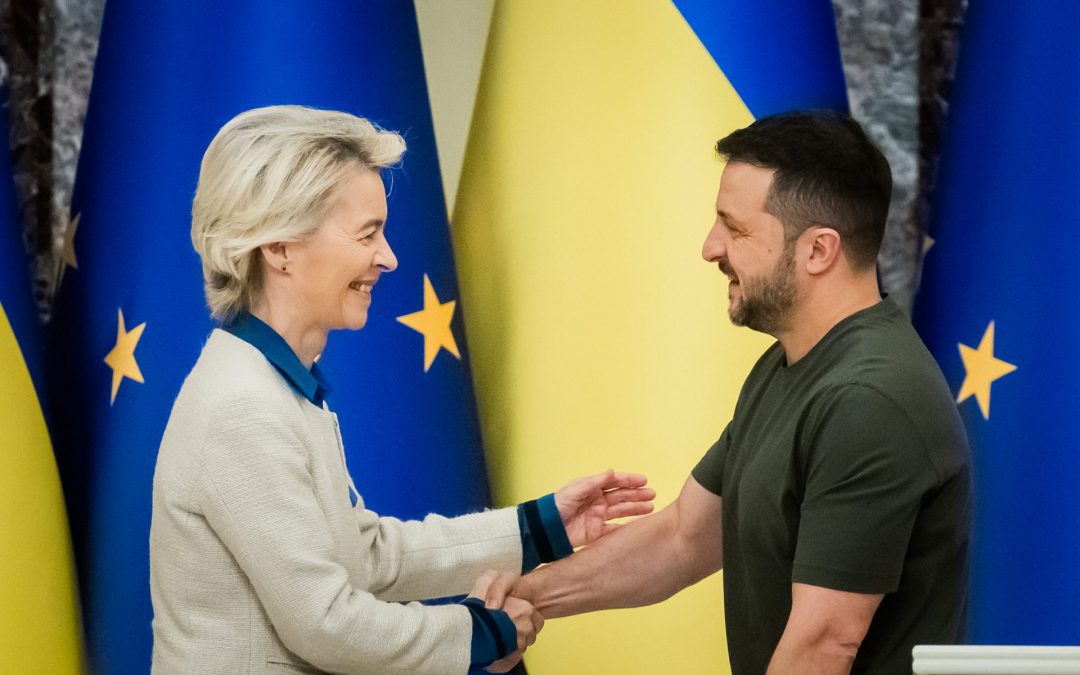 Have the article read by OpenAI (Beta). Please note that AI translations may take some time to process.
Have the article read by OpenAI (Beta). Please note that AI translations may take some time to process.European Commission President Ursula von der Leyen made her first trip to Kyiv after being re-elected to the post last week. She guaranteed European support for Ukraine ahead of winter, including a proposal for a 35-billion-Euro loan as well as additional financial support for the country’s ailing energy infrastructure and supply.
“My eighth visit to Kyiv comes at a crucial time. Heating season starts in two weeks and Russia’s relentless attacks on Ukraine’s civilian energy infrastructure aim to inflict maximum damage. We will help Ukraine in its brave efforts to overcome this,” the EU executive leader told European media on the ground, including the Portuguese news agency Lusa acting as a pool reporter on behalf of the European Newsroom (enr).
The Commission chief announced the plans for Brussels to lend Ukraine 35 billion Euro backed by revenues of frozen Russian assets and promised to help Ukraine “keep warm”.
The announcement comes after leaders of the G7 – a group of major Western industrialised nations including France, Germany, Italy, Japan, the United Kingdom, Canada and the United States as well as the EU as a “non-enumerated member” – had agreed last June on a 50-billion-Dollar loan to support the Ukrainian army and economy in the face of Russian aggression.
The International Energy Agency (IEA) has said Kyiv faces its “sternest test” so far ahead of the third winter of war with Russia, with Moscow expected to launch another bombing campaign on the country’s already damaged infrastructure.
The EU is to provide an additional 160 million Euro to Ukraine to help repair the damaged energy infrastructure, expand renewable energy, and finance shelters, von der Leyen said ahead of her trip.
EU steps in to help fix Ukraine’s crumbling power grid
An IEA report said that in 2022 and 2023 about “half of Ukraine’s power generation capacity was either occupied by Russian forces, destroyed or damaged, and approximately half of the large network substations were damaged by missiles and drones”.
“The European Union is here to help you in this challenge to keep the lights on, to keep your people warm, as winter is just around the corner, and to keep your economy going, as you fight for your survival,” von der Leyen said.
The EU’s 160-million-Euro support aims to repair infrastructure damaged by Russian bombing and restore – by this winter – 2.5 of the 10 gigawatts Ukraine has lost since March in successive Russian attacks. “That is approximately 15 percent of your country’s needs for this winter,” von der Leyen said.
Another pillar of the plan is to increase EU electricity exports to Ukraine until they reach two gigawatts when temperatures have dropped. “This covers approximately twelve percent of Ukraine’s needs for the winter,” she said.
According to Ukrainian information, 1.7 gigawatts can currently be imported from the EU and Ukraine’s south-western neighbour Moldova. The Ukrainian government had previously stated an increase to over 2.2 gigawatts as a target.
“With our two pillars, repair and connect, we cover over 25 percent of Ukraine’s needs for the winter,” von der Leyen said.

The energy aid package will also be dedicated to helping Ukraine decentralise its electricity generation system – and therefore make it less vulnerable to Russian missiles and drones – with the transfer of mobile gas turbines and solar panels.
Individual EU member states have repeatedly stressed their support for Ukraine’s energy sector.
At a G7 foreign ministers’ meeting in New York focused on support for Ukraine’s energy sector on Monday, Bulgarian caretaker Foreign Minister Ivan Kondov recalled details of Ukrainian President Volodymyr Zelenskyy’s visit to Bulgaria in July 2023. Back then, a Memorandum of Understanding on cooperation in the field of energy was signed between the Energy Ministries of Bulgaria and Ukraine and two joint working groups for natural gas and nuclear energy were created.
EU moves ahead with plan for G7 loan share
The EU and its member states have so far supported Ukraine with almost 120 billion Euro in grants and loans, according to the Commission. The money has been used to support Ukraine’s war effort, its economy and for humanitarian assistance.
Speaking about the proposed 35-billion-Euro loan at a joint press conference with Zelenskyy on Friday, von der Leyen said she was confident that the EU “can deliver this loan to Ukraine very quickly, a loan that is backed by the windfall profits from immobilised Russian assets”.
When asked if the European Union is moving forward because it fears other partners like the United States will lag behind, Ursula von der Leyen emphasised that the EU is doing “its part”.
“I am absolutely confident that the others will also do their part. For us, it was and is important that we are quick because the urgency is clear and this step now gives us the possibility to finalise the procedures,” she added.
Von der Leyen made it clear that Kyiv will be able to spend the money as it wants, including on weapons. Zelenskyy said it is crucial that Ukraine can use the funds to support its armed forces and that these funds must not be blocked, “because this would have an impact on our ability to support our military at the front”.
The Commission’s plan still has to be approved by the European Parliament and a majority of EU countries. In the past, Hungarian Prime Minister Viktor Orbán, who maintains good relations with Russia, has repeatedly hindered the bloc’s efforts to support Ukraine.
Ukraine has also lobbied its allies to allow it to use donated weapons to strike “legitimate” military targets deep in Russian territory. The United States and Britain have been discussing allowing it to do just that – but EU states remain divided over the issue.
Last Thursday, the European Parliament adopted a resolution calling on EU countries to allow Kyiv to use Western weapons to strike military targets inside Russia.
German Chancellor Olaf Scholz on Monday insisted that he will not loosen the rules for the use of German weapons in Ukraine’s defensive fight against Russia, despite the pleas from Kyiv. Scholz, who is in the United States to attend the UN General Assembly in New York, specified that this included restrictions that prevent Ukraine from firing missiles deep into Russian territory.
Zelenskyy is visiting the United States this week to present his proposals on how to end more than two and a half years of fighting to US President Joe Biden, as well as the two main candidates running to replace him – Vice President Kamala Harris and former president Donald Trump.
Zelenskyy has said he aims to host another international peace summit outlining his vision to end the war in November, to which Russia will be invited.
This article is published twice a week. The content is based on news by agencies participating in the enr.
